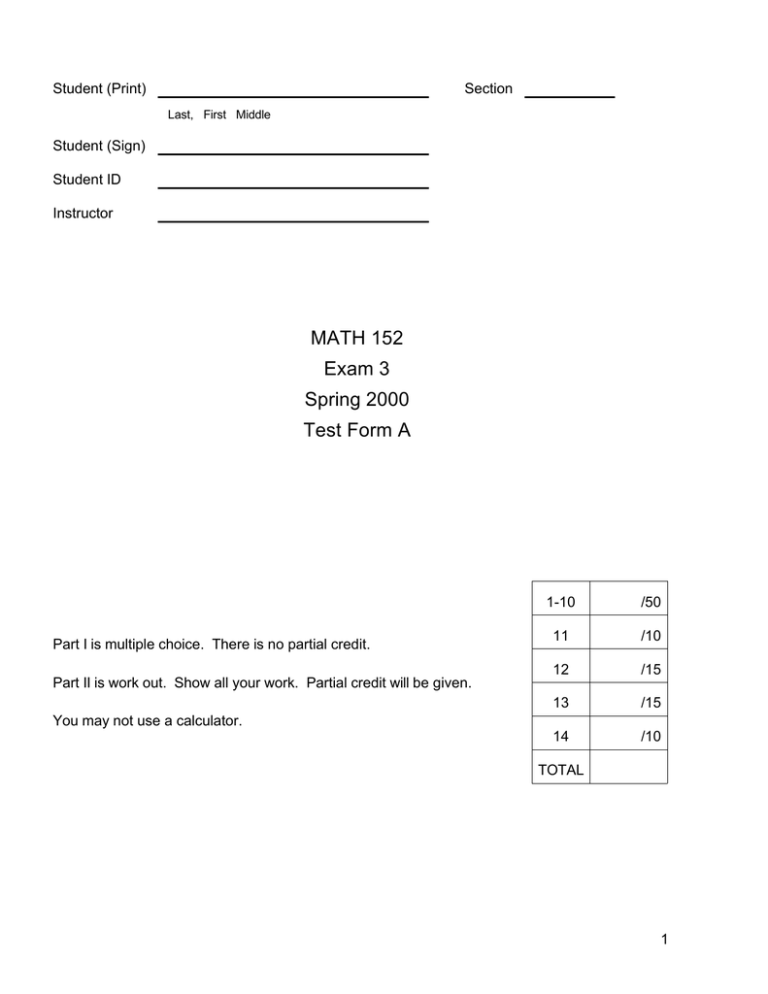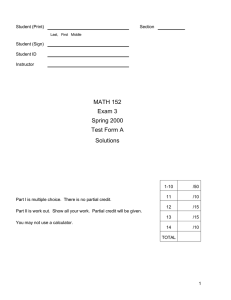MATH 152 Exam 3 Spring 2000 Test Form A
advertisement

Student (Print) Section Last, First Middle Student (Sign) Student ID Instructor MATH 152 Exam 3 Spring 2000 Test Form A Part I is multiple choice. There is no partial credit. Part II is work out. Show all your work. Partial credit will be given. 1-10 /50 11 /10 12 /15 13 /15 14 /10 You may not use a calculator. TOTAL 1 Part I: Multiple Choice (5 points each) There is no partial credit. You may not use a calculator. 1. Find the values of x such that the vectors x, "1, 3 and 2, "5, x are orthogonal. a. "1 only b. 0 only c. 1 only d. 0 and 1 only e. 1 and "1 only x 3 lim e " 16 " x xv0 x HINT: The series for e x may be helpful. a. 0 b. 1 3! c. " 1 3! d. 1 2 3 2. Compute e. . 3. Consider the parametric curve rt t, sin t, t 3 . Find parametric equations for the line tangent to the curve at t =. a. x 1 =t, y "t, z 3= 2 = 3 t b. x 1 =t, y "1, z 3= 2 = 3 t c. x = t, y "1 t cos t, z = 3 3t 3 d. x = t, y t cos t, z = 3 3t 3 e. x = t, y "t, z = 3 3= 2 t 4. Find the Taylor series for fx x 2 3 about x 2. a. 7 4x " 2 x " 2 2 b. 7 4x " 2 2x " 2 2 4x " 2 3 c. 7 4x " 2 x " 2 2 2 x " 2 4 C 3 d. 7 4x " 2 2x " 2 2 4x " 2 3 2x " 2 4 C e. 7 4x " 2 2x " 2 2 2 x " 2 3 4 x " 2 4 3 3 2 5. The vectors a, b and c b" a all lie in the same plane as shown in the diagram. Which of the following statements is TRUE? a. a b 0. b. a b points into the page. a b c. c 0. d. b a c points in the direction of " a. e. None of These 6. Find a power series centered at x 0 for the function fx of convergence. ! ! ! ! ! . a. " 1 n n 3n1 R 1 8 " 1 n n 3n1 R8 8 x n0 . b. 8 x x , and determine its radius 1 " 8x 3 n0 . c. 8 n x 3n1 n! n0 . d. 8 n x 3n1 R 1 8 8 n x 3n1 R 1 2 n0 . e. R2 n0 7. Find the distance from the point 3, "2, 4 to the center of the sphere x " 1 2 y 1 2 z " 2 2 4 a. b. c. d. e. 2 3 9 61 61 3 8. Let fx sinx 2 . Compute f 14 0 , the 14 th derivative of fx evaluated at 0. HINT: Use a series for sinx 2 . 1 a. " 14! 7! b. 7! 14! c. 14! 7! d. " 14! 7! e. "14! 7! 9. Find the angle between the vectors u 1, 1, 0 and v 1, 2, 1 . a. 0° b. 30° c. 45° d. 60° e. 90° ! ! ! ! ! . a. " 1 n0 . b. n0 . c. n0 . d. n0 . e. n0 1 3n 1 " 1 n 3n 1 "1 3n n " 1 3n 1 2 n n 3n " 1 1 2 1 2 ; 1/2 1 dx as an infinite series. 1 x3 1 " 13 16 " 19 C 2 2 2 10. Evaluate the integral 0 3n1 3n1 2 1 1 1 C 4 24 7 27 10 2 10 1 " 1 1 " 1 C 4 24 10 2 10 7 27 2 " 1 1 2 1 2 1 3n"1 3n"1 " 2 " 22 55 " 88 C 2 "2 " 2 2 1 1 " 1 C 2 22 5 25 8 28 4 Part II: Work Out (points indicated below) Show all your work. Partial credit will be given. You may not use a calculator. 11. (10 points) Consider the planes P1 : 2x " y z 1 P2 : x y " 3z 2 a. (2 pts) Fill in the blanks: A normal to the plane P 1 is N 1 A normal to the plane P 2 is N 2 b. (3 pts) Find a vector parallel to the line of intersection of the two planes. c. (3 pts) Find a point on the line of intersection of the two planes. d. (2 pts) Find parametric equations for the line of intersection of the two planes. 5 12. (15 points) Let fx lnx. a. (10 pts) Find the 3 rd degree Taylor polynomial T 3 for fx about x 2. b. (5 pts) If this polynomial T 3 is used to approximate fx on the interval 1 t x t 3, estimate the maximum error |R 3 | in this approximation using Taylor’s Inequality. M |x " 2|n1 where M u f n1 x for 1 t x t 3. |R n x | n 1 ! 6 13. (15 points) Consider the points P 1, 0, "1 , Q 2, 3, 1 and R 0, 4, 1 a. (5 pts) Find a vector orthogonal to the plane determined by P, Q and R. b. (5 pts) Find the area of the triangle with vertices P, Q and R. c. (5 pts) Find the equation of the plane determined by P, Q and R. 7 14. (10 points) Find the radius of convergence and the interval of convergence of the series ! . n0 n 1 x " 2 . 3n n 1 8






